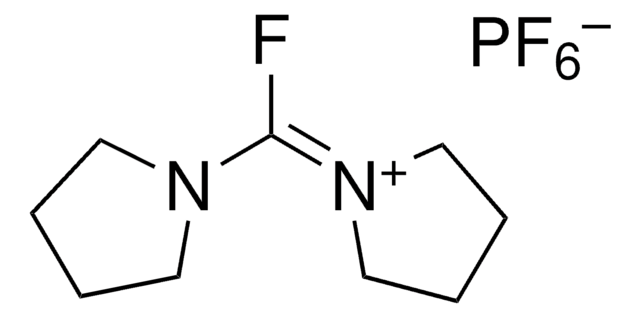529249
2-Chloro-1,3-dimethylimidazolinium chloride
for peptide synthesis
Sinónimos:
2-Chloro-4,5-dihydro-1,3-dimethyl-1H-imidazolium chloride, DMC
About This Item
Productos recomendados
product name
2-Chloro-1,3-dimethylimidazolinium chloride,
form
crystalline
reaction suitability
reaction type: Coupling Reactions
mp
133-140 °C (lit.)
application(s)
peptide synthesis
SMILES string
[Cl-].CN1CC[N+](C)=C1Cl
InChI
1S/C5H10ClN2.ClH/c1-7-3-4-8(2)5(7)6;/h3-4H2,1-2H3;1H/q+1;/p-1
InChI key
AEBBXVHGVADBHA-UHFFFAOYSA-M
Application
Tagged glucose as an intermediate in the synthesis of branched oligosaccharides
Fluorescent chemosensors
1,2-Diamines as inhibitors of co-activator associated arginine methyltransferase 1
Allosteric glucokinase activators
Reactant for synthesis of:
Organic azides from primary amines
Reagent for aza-Henry reactions
signalword
Warning
hcodes
Hazard Classifications
Eye Irrit. 2 - Skin Irrit. 2 - STOT SE 3
target_organs
Respiratory system
Storage Class
11 - Combustible Solids
wgk_germany
WGK 3
flash_point_f
Not applicable
flash_point_c
Not applicable
ppe
dust mask type N95 (US), Eyeshields, Gloves
Certificados de análisis (COA)
Busque Certificados de análisis (COA) introduciendo el número de lote del producto. Los números de lote se encuentran en la etiqueta del producto después de las palabras «Lot» o «Batch»
¿Ya tiene este producto?
Encuentre la documentación para los productos que ha comprado recientemente en la Biblioteca de documentos.
Los clientes también vieron
Artículos
N-Acylimidazoles and carbonylimidazoles are reactive intermediates used for amino compound acylation, surpassing DCC as coupling reagents.
N-Acylimidazoles and carbonylimidazoles are reactive intermediates used for amino compound acylation, surpassing DCC as coupling reagents.
N-Acylimidazoles and carbonylimidazoles are reactive intermediates used for amino compound acylation, surpassing DCC as coupling reagents.
N-Acylimidazoles and carbonylimidazoles are reactive intermediates used for amino compound acylation, surpassing DCC as coupling reagents.
Nuestro equipo de científicos tiene experiencia en todas las áreas de investigación: Ciencias de la vida, Ciencia de los materiales, Síntesis química, Cromatografía, Analítica y muchas otras.
Póngase en contacto con el Servicio técnico














